Ommastrephidae
Richard E. Young, Michael Vecchione, and Martina A. Compagno Roeleveld


This tree diagram shows the relationships between several groups of organisms.
The root of the current tree connects the organisms featured in this tree to their containing group and the rest of the Tree of Life. The basal branching point in the tree represents the ancestor of the other groups in the tree. This ancestor diversified over time into several descendent subgroups, which are represented as internal nodes and terminal taxa to the right.

You can click on the root to travel down the Tree of Life all the way to the root of all Life, and you can click on the names of descendent subgroups to travel up the Tree of Life all the way to individual species.
For more information on ToL tree formatting, please see Interpreting the Tree or Classification. To learn more about phylogenetic trees, please visit our Phylogenetic Biology pages.
close boxIntroduction
Members of the Ommastrephidae are small (about 10 cm ML) to large (about 100 cm ML), muscular squids that are often the dominant large squids in oceanic and, occasionally, neritic waters. A number of species are fished commercially. Although the family is very well characterized, placement of species with genera and subfamilies has, in some cases, been controversial. These controversies have often revolved around the importance of absence of a character (e. g., absence of foveola and side pockets from the funnel groove of Todaropsis, a featured shared with Illex) which, without adequate polarization, could be interpreted as a synapomorphy, a symplesiomorphy, or a convergent loss.
Brief diagnosis
An oegopsid squid ...
- with an inverted T-shaped funnel/mantle locking-apparatus.
- with fused tentacles in paralarvae.
Characteristics
- Funnel/mantle locking-apparatus with an inverted T-shape.
 Click on an image to view larger version & data in a new window
Click on an image to view larger version & data in a new window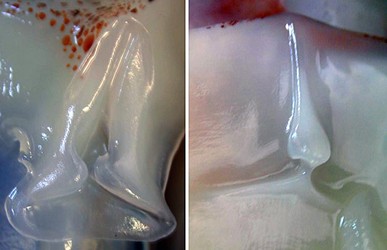
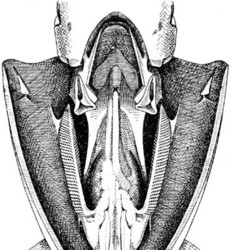
Figure. Frontal views of the funnel/mantle locking apparatus. Left - Funnel component of Illex illecebrosus. Middle - Mantle component of Illex illecebrosus. Photographs by M. Vecchione. Right - Opened mantle cavity showing the funnel/mantle locking apparatus of Todaropsis eblanae. Drawing from Naef (1921-23).
- Funnel adductor muscles
- Thick lateral funnel-adductor muscles connect lateral edges of funnel with head near its ventral surface. [These muscles are not homologous with the more superficial muscles of the Sepioidea which bear the same name.]
 Click on an image to view larger version & data in a new window
Click on an image to view larger version & data in a new window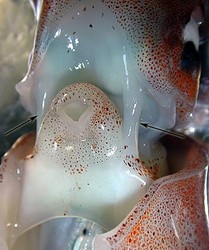
Figure. Ventral view of the funnel of Illex illecebrosus showing the strong lateral adductor muscles (arrows). These muscles are also seen in the drawing of Todaropsis eblanae above. Photograph by M. Vecchione.
- Thick lateral funnel-adductor muscles connect lateral edges of funnel with head near its ventral surface. [These muscles are not homologous with the more superficial muscles of the Sepioidea which bear the same name.]
- Paralarvae (rhynchoteuthion stage) with fused tentacles.
 Click on an image to view larger version & data in a new window
Click on an image to view larger version & data in a new window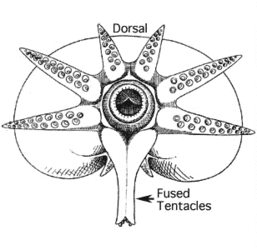
Figure. Rhynchoteuthion paralarvae. Left - Oral view, species unknown. Drawing modified from Naef (1921-23). Middle -Ventral view of Ommastrephes bartramii, 4 days old, living. Photograph by Y. Sakurai. Right - Ventral view of Sthenoteuthis oualaniensis, advanced, fresh. Photograph by R. Young.
- Arms with biserial suckers.
- Tentacular clubs with quadraserial suckers (club dactylus with eight sucker series in Illex).
- Buccal connectives attach to dorsal borders of Arms IV.
- Distinctive, slender gladius with primary conus.
| Photophores present1 | Dactylus suckers | Funnel- groove foveola | Funnel- groove side pockets | Distal protective membranes on hectocotylus | Carpal locking apparatus2 | |
| Illicinae | No | 8 series | No | No | Absent | Absent |
|---|---|---|---|---|---|---|
| Ommastrephinae | Yes | 4 series | Yes | Yes | Ventral membrane enlarged subdistally | Present except Ornithoteuthis |
| Todarodinae | No | 4 series | Yes/No | No | Ventral membrane with thickened trabeculae | Absent |
2Defined as presence of knobs and corresponding suckers with smooth sucker rings.
Nomenclature
A list of all nominal genera and species in the Ommastrephidae can be found here. The list includes the current status and type species of all genera, and the current status, type repository and type locality of all species and all pertinent references.
Discussion of Phylogenetic Relationships
The relationships presented here are from the phylogenetic study by Roeleveld (1988). The relationships are based on a number of different structures but rely heavily on the structure of the hectocotylus. The lack of known relationships among outgroups makes rooting of the tree difficult. Not all workers agree with the subfamial placement of genera (e.g. Nesis, 1982/7; Wormuth, et al., 1998).
References
Nesis, K. N. 1982. Abridged key to the cephalopod mollusks of the world's ocean. 385+ii pp. Light and Food Industry Publishing House, Moscow. (In Russian.). Translated into English by B. S. Levitov, ed. by L. A. Burgess (1987), Cephalopods of the world. T. F. H. Publications, Neptune City, NJ, 351pp.
Roeleveld, M. A. 1988. Generic interrelationships within the Ommastrephidae (Cephalopoda). P.277-314. In: M. R. Clarke and E. R. Trueman (eds.). The Mollusca. Vol. 12. Paleontology and Neontology of Cephalopods. Academic Press, N.Y., 355pp.
Wormuth, J. 1998 Workshop deliberations on the Ommastrephidae; a brief history of their systematics; and a review of the systematics, distribution and biology of the genera Martialia Rochebrune and Mabille, 1889, Todaropsis Girard, 1890, Dosidicus Steenstrup, 1857, Hyaloteuthis Gray, 1849, and Eucleoteuthis Berry, 1916. Smithson. Contr. Zool., No. 586:373-384..
Title Illustrations

| Scientific Name | Nototodarus hawaiiensis |
|---|---|
| Location | off Hawaii |
| Copyright |
© 1996 Richard E. Young

|
About This Page
Richard E. Young

University of Hawaii, Honolulu, HI, USA

National Museum of Natural History, Washington, D. C. , USA
Martina A. Compagno Roeleveld

South African Museum, Cape Town, South Africa
Page copyright © 1995 Richard E. Young, , and
- Content changed 06 April 2007
Citing this page:
Young, Richard E., Vecchione, Michael, and Compagno Roeleveld, Martina A. . 2007. Ommastrephidae . Version 06 April 2007. http://tolweb.org/Ommastrephidae/19418/2007.04.06 in The Tree of Life Web Project, http://tolweb.org/





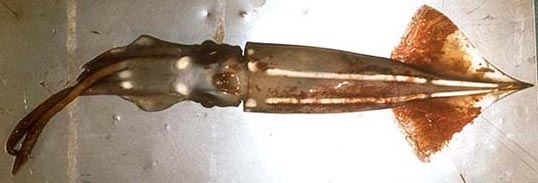



 Go to quick links
Go to quick search
Go to navigation for this section of the ToL site
Go to detailed links for the ToL site
Go to quick links
Go to quick search
Go to navigation for this section of the ToL site
Go to detailed links for the ToL site